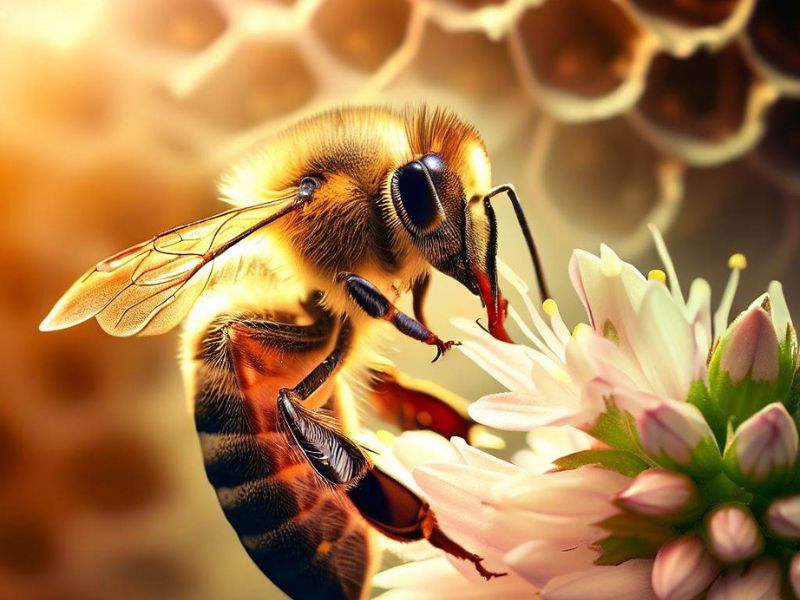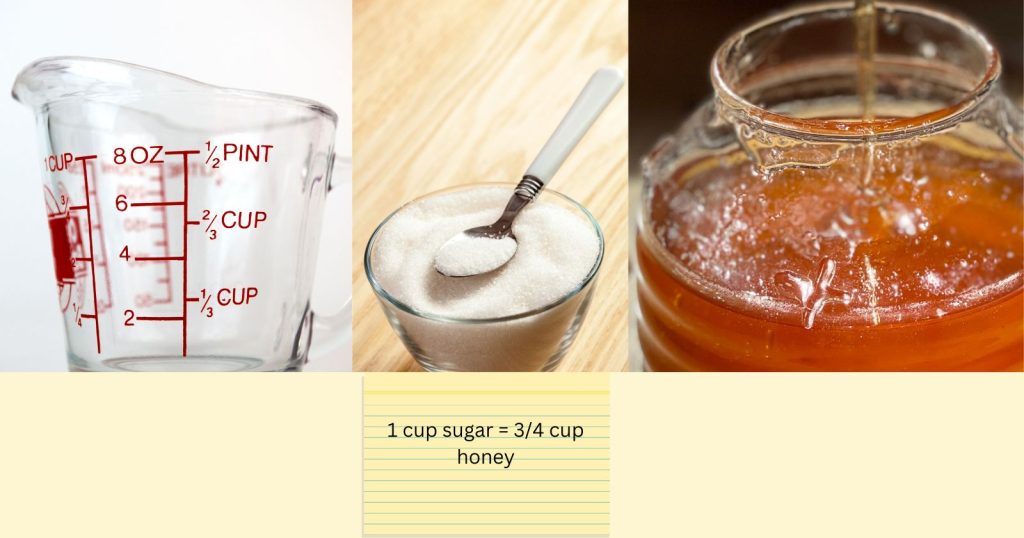Ever wondered, “How do I substitute honey for sugar in baking?” Swapping sugar for honey might sound tricky, but it’s easier than you think. Honey gives a special touch to our favorite treats, making them even tastier. Plus, it’s a natural sweetener that comes straight from nature. Let’s take a closer look and learn how to make this simple switch in our recipes.
What Is Honey?

Honey, often referred to as “liquid gold,” is a marvel of nature. Produced by bees from the nectar of flowers, it’s a complex substance that offers more than just sweetness. Let’s explore the complex structure and characteristics of this natural sweetener.
At its core, honey is a blend of sugars, water, and other compounds. But what makes it so special?
- Fructose and Glucose: These are the primary sugars in honey, with fructose being the dominant one. This composition is responsible for honey’s distinct sweetness, which is slightly different from regular table sugar.
- Water: Honey’s water content can vary, but it generally hovers around 17%. This moisture plays a pivotal role in baking, influencing everything from consistency to shelf life.
- Enzymes: Bees introduce enzymes to honey, which can break down some of the sugars. This process can produce compounds that give honey its unique flavor profiles. One such enzyme, invertase, breaks sucrose down into glucose and fructose, further enhancing honey’s natural sweetness.
The Magic Of The Bee
Bees play a crucial role in transforming flower nectar into the honey we know and love. They collect nectar, which is primarily water and sucrose, and store it in their honey stomach. Here, enzymes begin breaking down the sucrose. Once in the hive, bees further process the nectar, reducing its water content by fanning it with their wings. The result? The thick, viscous honey that’s a baker’s delight.
Varieties and Flavor Profiles
Not all honeys are created equal. Depending on the flowers bees visit, honey can have vastly different flavors and colors:
- Clover Honey: Light and mildly sweet, it’s a versatile choice for most baking needs.
- Manuka Honey: Darker with a strong flavor profile, it’s known for its medicinal properties.
- Orange Blossom Honey: As the name suggests, it has a delightful citrus undertone.
- Buckwheat Honey: Dark and robust, it’s almost molasses-like in flavor.
For a more in-depth explanation of the varieties of honey, read this
Honey’s Role in Baking

Beyond sweetness, honey introduces acidity to baked goods, which can activate leavening agents like baking soda. It’s also hygroscopic, meaning it attracts moisture. This can make baked goods moister and extend their shelf life.
Honey’s caramelization point is lower than that of granulated sugar. This means baked goods can brown faster, producing a delightful golden color and a slightly different texture.
How Do I Substitute Honey For Sugar In Baking?

Substituting honey for sugar isn’t just about swapping one sweetener for another. It’s about understanding the nuances of honey and making the necessary adjustments to ensure your baked goods turn out perfect every time. Here’s a detailed guide to help you make the switch with confidence.
Conversion Ratios
The first step in any substitution is knowing the right amounts:
- Basic Rule: Because honey is sweeter than granulated sugar, you will need to use 3/4 cup of honey for every 1 cup of granulated sugar
- Liquid Adjustments: Because honey is a liquid and sugar a solid, you may have to reduce the amount of liquid called for in your recipe. If not, your batter will be too thin, leading to the final baked good with the wrong texture. A good rule to follow is to reduce the total amount of liquid by 1/4 cup for every 1 cup of honey. For example, the recipe calls for 1 cup of honey. 1 cup of oil and 1 cup of milk. Reduce the oil and milk by 1/8 cup for each for a total of 1/4 cup.
Adjusting Baking Temperatures and Times
Honey’s unique composition means it behaves differently than sugar when exposed to heat:
- Temperature: Honey can cause baked goods to brown more quickly. To correct this, reduce your oven temperature by 25°F. This ensures even baking without the risk of over-browning.
- Baking Time: Due to honey’s moisture content, baked goods might take a tad longer to set. It’s essential to keep a close eye on your treats, especially the first time you’re trying a new substitution. A toothpick test or gentle touch can help determine doneness.
Pairing Honey with Other Ingredients
Honey’s distinct flavor can elevate many recipes, but it’s essential to ensure it blends well with other ingredients:
- Acidic Ingredients: Honey is naturally acidic. If a recipe calls for cream of tartar or another acid, you might consider reducing the amount slightly to maintain balance.
- Leavening Agents: The acidity in honey can activate baking soda, a common leavening agent. If you’re substituting a significant amount of sugar with honey, consider increasing the baking soda by about 1/8 teaspoon for every cup of honey.
- Flavor Complements: Think about the flavor profile of your dish. Warm spices like cinnamon, nutmeg, and cloves can enhance honey’s natural flavors. On the other hand, strong flavors like coffee or dark chocolate might require a bit of tweaking to ensure they don’t overpower the honey.
Adjusting for Texture
- For Cookies: If you like them crispy, you might need to experiment a bit. Honey tends to make cookies softer and chewier. Consider reducing other moist ingredients or baking a tad longer for a crisper result.
- For Cakes and Muffins: Honey can make these delightfully moist. However, be cautious of overmixing, as this can make them too dense.
- For Breads: Honey not only adds flavor but can also provide a beautiful crust. Monitor the dough’s consistency and adjust flour or liquids as needed.
Tips and Tricks For Baking With Honey

Baking with honey is a delightful experience, but like any ingredient, it has its quirks. Whether you’re a seasoned baker or just starting your honey-infused journey, these tips and tricks will help you navigate the sweet world of honey in baking.
Choosing the Right Honey
Not all honeys are created equal, and the type you choose can significantly influence your baked goods:
- Raw vs. Processed: Raw honey retains more of its natural flavor and nutrients, making it a preferred choice for many bakers. Processed honey, while smoother, might lack some of the depth of flavor.
- Flavor Profiles: Lighter honey, like clover or acacia, offers a subtle sweetness, making it versatile for various recipes. Darker honey, like buckwheat or chestnut, has robust flavors that can shine in recipes where honey is the star.
Measuring Honey Accurately
Honey’s sticky nature can make it a bit tricky to measure:
- Oil the Measuring Cup: Lightly greasing your measuring cup or spoon with oil can make it easier to pour out the honey without leaving too much behind.
- Use a Scale: For precision, consider weighing your honey. This ensures you get the exact amount needed for your recipe.
Preventing Over-Browning
Honey’s natural sugars can cause baked goods to brown faster:
- Tent with Foil: If you notice the top browning too quickly, especially for items like bread or muffins, tenting with foil can prevent burning while allowing the inside to bake thoroughly.
- Position in the Oven: Placing your baked goods in the center or even slightly lower can help with even baking. The bottom of the oven is generally cooler than the top.
Storing Honey-Based Baked Goods
Honey’s hygroscopic nature means it attracts moisture, which can influence how you store your treats:
- Airtight Containers: To retain moisture and keep baked goods fresh, store them in airtight containers. This prevents them from drying out.
- Refrigeration: While refrigeration can extend the shelf life, it might alter the texture, especially for cakes and bread. If you do refrigerate, consider warming the baked goods slightly before serving.
Is sugar really necessary when it comes to baking our goodies? Check this out
Final Thoughts

Baking with honey is like going back in time. It’s a sweet reminder of how simple and pure things used to be. Honey isn’t just sweet; it’s nature’s gift to us. Every drop tells a story of hardworking bees and beautiful flowers.
When we use honey in our baking, we’re choosing something real and natural. It’s a small way to bring a bit of nature into our kitchens. And the best part? It tastes amazing!
But remember, baking is about having fun and trying new things. So, give honey a go in your next recipe. You might be surprised at how something so simple can make such a big difference.
So, the next time you enjoy a treat sweetened with honey, think of the journey it’s been on. From the tiny bee to your tasty treat, it’s a sweet story worth celebrating.
Have you used honey instead of sugar in your baked goods? Please leave me a comment below.
And As Always
Keep On Baking!
Taianne
Share The Love

I’m Taianne, the owner and operator behind We Are Baking. Baking my first cake at age 11 hooked me on creating sweet treats. Though my interest faded during childhood, it was rekindled when I married my apple pie-loving husband. I love trying new recipes, tweaking classics, and helping others learn the science and art of baking. I started We Are Baking to share tips, tricks, and favorite recipes I’ve discovered over the years. When not in the kitchen, I enjoy spending time with family and friends. My goal is to inspire others to embrace their creativity through baking. Feel free to contact me with any questions!
Taianne@wearebaking.com

